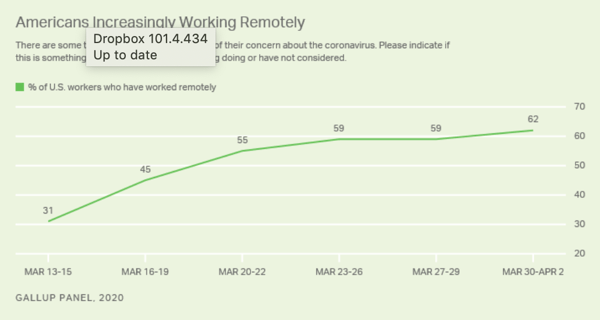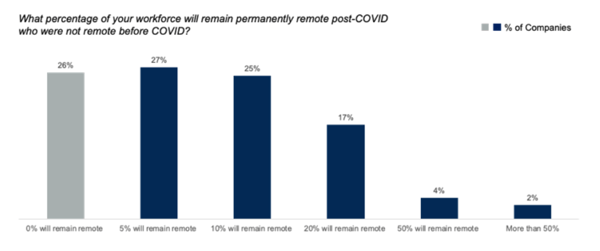The C.O.P.E. Approach: 4 Ways to Make Working from Home Easier for Your Employees



 Cut onboarding time
by 60%—here's the
Ultimate Checklist
that helped do it.
Cut onboarding time
by 60%—here's the
Ultimate Checklist
that helped do it.

The COVID-19 pandemic has made remote working the only way to keep many businesses running as companies across all sectors have been compelled to limit site-based activities in the interest of public health.
A Gallup survey has revealed that the number of US employees who work remotely has doubled from 31% to 62% since the pandemic started.

The COVID-19 pandemic has caused an upsurge in the number of employees who were working from home as authorities impose lockdown regulations to slow down the spread of the virus (Image Source).
What’s interesting is that remote work could be the new normal even after the COVID-19 scare is over. For instance, Twitter CEO Jack Dorsey announced that “if our employees are in a role and situation that enables them to work from home and they want to continue to do so forever, we will make that happen.”
This is echoed by a Gartner report, which found that 74% of businesses are planning to make at least 5% of their employees work remotely, permanently.

Although remote working started out as a COVID-19 continuity measure, for most companies it’s here to stay (Image Source).
The Challenges Newly Transitioned Remote Employees Face
While workers who have recently switched to a remote work arrangement are enjoying many benefits such as eliminating their commute to and from the office, they are also facing a number of challenges. According to Buffer’s State of Remote Work 2020, the biggest challenges remote workers face include:
-
Loneliness
-
Not being able to unplug
-
Distractions at home
-
Staying motivated
New remote workers may also struggle with the above challenges. Additionally, a separate survey by the messaging platform Slack shows that those who are new to working from home struggle more in the following 3 areas compared to their more experienced counterparts:
-
Productivity
-
Sense of belongingness
-
Overall satisfaction with work arrangement
Franchise Owner of Interim HealthCare SLC
“Interim Healthcare SLC needed HR technology, and we’re pleased with the results we’ve gained from HR Cloud’s solutions for recruiting, onboarding, and employee engagement. Yet it’s an opportunity for all Interim franchises. It would be so great if each franchise owner could implement similar solutions to replace legacy systems that might not work as well as they should.”
Thriving in a work from home environment requires collaborative efforts between you and your team. Adjusting your systems and providing your employees with the right tools are prerequisites to making remote work a viable continuity strategy for your business. Below are 4 ways to C.O.P.E. with working from home for your employees:
C - Capitalize on Technology
The lack of physical proximity is the biggest change that new remote workers need to cope with. Suddenly, co-workers who could previously be accessed within a few steps are miles away.
This physical gap must be bridged using tools and technology. Technology is what has enabled remote work in the first place. The strategic and thoughtful use of technology is needed for your employees to ease their transition to a work from home environment.
At bare minimum, it’s necessary to have the tools and technology in order to accomplish the following:
-
Communication and collaboration
-
Task delegation, project management, progress monitoring
-
Attendance, time monitoring, and productivity tracking
-
File sharing
-
Feedback and employee engagement
These tools and technologies foster accountability among new remote employees to track and manage their own productivity and encourage them to allocate their resources and time more efficiently. As for managers, these systems give them eyes and ears that enable them to ensure that projects stay on schedule and on budget. Overall, they make sure that everyone is on the same page so nothing falls through the cracks.
O - Operationalize Daily Check-Ins
Almost all successful remote teams have structured daily check-ins. The agenda may vary day-to-day. For instance, Mondays can be spent planning weekly project schedules, while Fridays can be dedicated to reviewing the accomplishments and the challenges of the week. You can also dedicate days for one-on-one check-ins.
The key is for these daily check-ins to be regularly scheduled, predictable, and to have clear agendas.

P - Practice Flexibility
One of the unique aspects of remote work is that you need structure. However, at the same time, you need to allow room for flexibility. Businesses should take into consideration that blending home-life and work-life comes with interruptions and distractions that disrupt an employee’s normal work patterns.
It’s important to be able to think beyond the traditional 9 to 5 mentality and embrace more flexible work arrangements. It may sound challenging at first, but remote teams that thrive embrace flexibility and agility. Here are a few of the things you need to consider:
-
Master asynchronous communication
-
Set certain hours wherein your team members’ work hours overlap
-
Use shared calendars so you know when everyone is working and when things are getting done
This is closely related to the first element of this approach, which is technology. The more strategically you use technology, the more flexible and agile your team can be. For instance, time monitoring tools allow you to ensure that employees are working when they’re supposed to, which allows them to determine their own pre-plotted schedules.

E - Ease Stress and Anxiety
These are extraordinary times. Tension is high and uncertainty is rampant. As explained by the Center for Workplace Mental Health, “Many are teleworking full-time for the first time, isolated from co-workers, friends, and family. Our daily living routines are disrupted causing added anxiety, stress, and strain—physically, mentally, and financially. It is completely natural for this disruption and uncertainty to lead to anxiety and stress.”
One of the most important and yet overlooked steps to help employees adjust to remote work is easing their stress and anxiety. Left unaddressed, stress and anxiety create hurdles for employees and businesses to truly thrive in a work from home setup.
So, what can you do?
-
Communicate empathetically: Employers and managers need to consistently talk to their employees in a way that they feel supported and cared for. Show empathy. Acknowledge that any anxiety they’re feeling is valid and offer support where you can.
-
Demonstrate transparency: This is not the time for closed-door, managers-only meetings. Be transparent about what’s going on in your organization and the steps you’re taking to ensure business continuity. Make your employees feel that all possible scenarios have been explored.
-
Promote self-care: Encourage employees to spend time outside of work to take care of themselves. Recommend activities that they can do in the safety of their homes such as meditation, breathing exercises, and yoga.
-
Create fun activities: Host virtual happy hours or online games—anything that will allow your employees to share light-hearted, non-work related moments with each other.
Help Your New Remote Employees C.O.P.E.
Remote work is here to stay for the foreseeable future. Whether you decide to have your employees permanently work from home, move to a hybrid setup, or just wait until the COVID-19 pandemic becomes more manageable, helping your newly transitioned work from home employees is pertinent so your business continues to function.
Using the C.O.P.E. approach, which combines technology, regular check-ins, flexible scheduling, and mental health management, is a perfect jump-off point for you to help your employees not only survive but to thrive in this new normal.
About author:
Dean Mathews is the founder and CEO of OnTheClock, an employee time tracking app that helps over 9,000 companies all around the world track time.
Dean has over 20 years of experience designing and developing business apps. He views software development as a form of art. If the artist creates a masterpiece, many people’s lives are touched and changed for the better.
When he is not perfecting time tracking, Dean enjoys expanding his faith, spending time with family, friends and finding ways to make the world just a little better.

Keep Reading
45 Boss Day Messages That Actually Mean Something (2026 Guide)
When is Boss Day 2026? Mark your calendar for October 16, 2026 — the annual opportunity
Birthday Wishes for Coworkers: 50+ Messages That Build Workplace Connection
A coworker's birthday isn't just another calendar date—it's a meaningful opportunity to
Embracing Diversity: Recognizing Different Cultures in the Workplace
Workplaces today reflect the incredible diversity of the world around us. People bring
Like What You Hear?
We'd love to chat with you more about how HR Cloud® can support your business's HR needs. Book Your Free Demo

Build a Culture of Recognition. Boost Engagement. Guaranteed.
Workmates empowers employees to stay informed, connected, and appreciated—whether they’re on the front line, in the office, or remote. Recognition drives 12x higher engagement.Trusted by industry leaders in every sector




Cut Onboarding Costs by 60%.
Take the confusion and follow-ups out of onboarding with automated workflows, digital forms, and structured portals—so new hires ramp faster 3X quicker.Trusted by industry leaders in every sector





